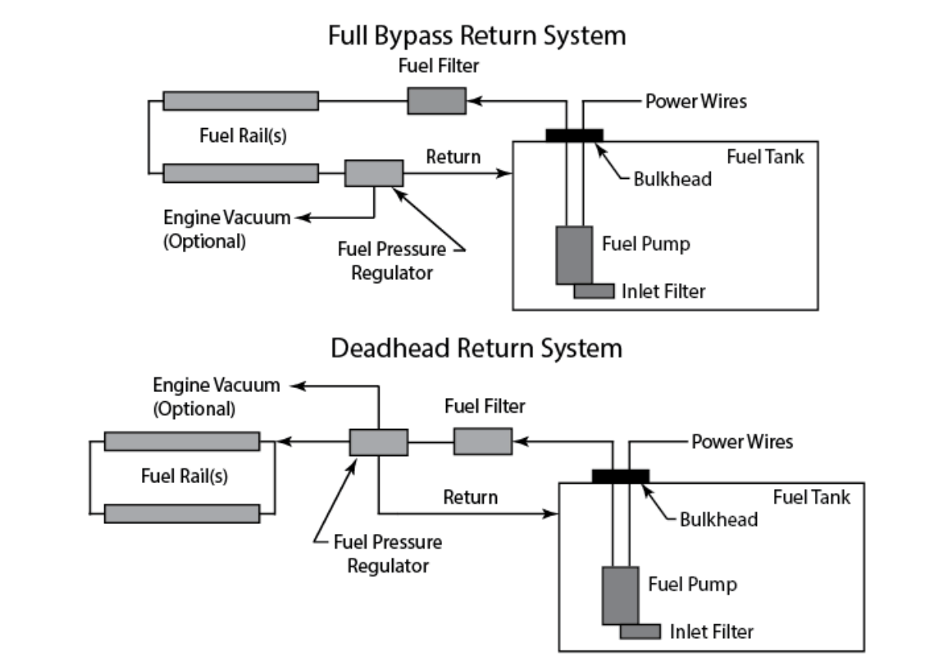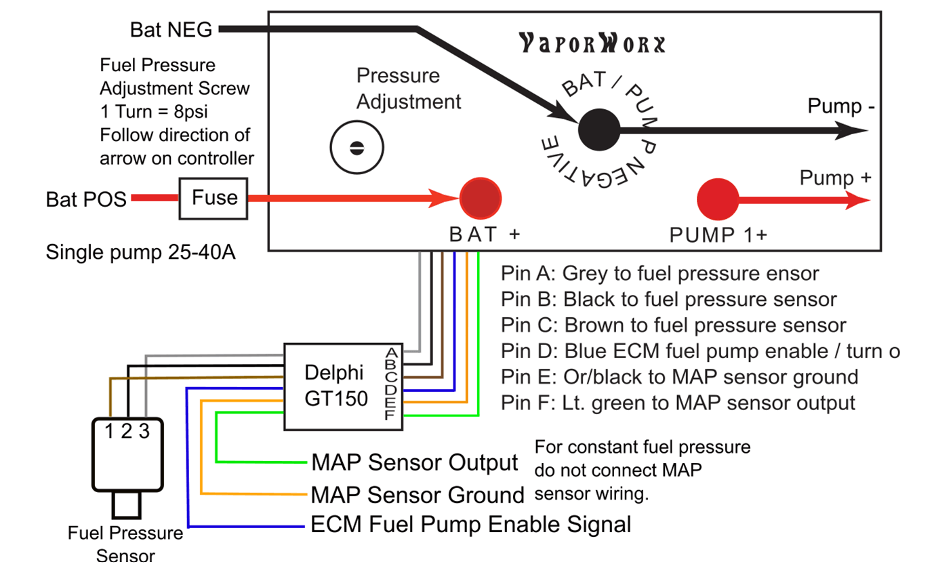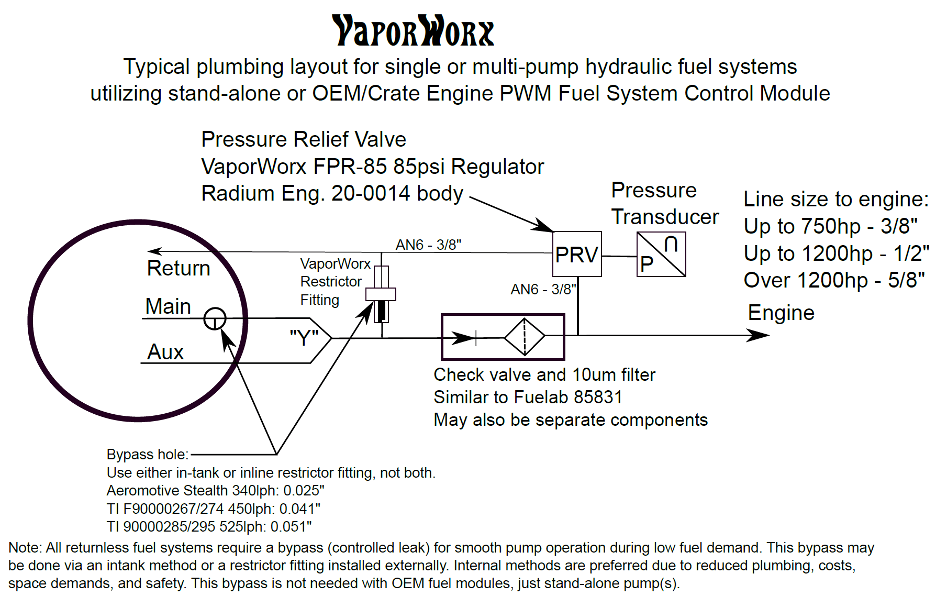To Return or Not To Return (Returnless), That is the Question for Naked, Stand-Alone Fuel Pumps.
The advantages of using Pulse Width Modulation are numerous. Just about every modern OEM vehicle uses PWM to slow down the fuel pump(s) for several reasons:
- Less power demand. With pumps being about 1/3 efficient, when at idle/cruise nearly all of the power going to the pump ends as heat being added to the fuel load.
- Lower fuel temperatures. Fuel is the lubricant and coolant for the pump. Hot fuel has lower lubricity properties than cool fuel. Less chance of vapor lock is another benefit.
- Lower pump wear. Which wears faster, an engine running at 6500rpm all the time, or an engine where a throttle is used to meet the power demand?
- Lower noise. Who wants a fuel pump screaming when there’s a nice exhaust tone to listen to?
Today’s OEM fuel systems are nothing like those from just a few chassis generations ago.
The 325hp LS1 Camaro was the hot car 25 years ago.
That’s easily done in a stock V6 today.
Fuel systems had to evolve so that the reliability of the much larger pumps will meet the expectations of the customers.
The modern Pulse Width Modulation systems are far more expensive than a simple mechanical regulator. They earned their way into the modern car.
How often are 650hp+ fuel pumps changed in modern cars? PWM is the key. More on that later.
A bit of background on return and returnless systems… Okay, a lot.
Return Fuel Systems
In a return fuel system the pump traditionally runs full speed and the excess not used by the engine is returned to the fuel load (tank) by means of a pressure regulator.
The pressure regulator performs two basic functions:
- It mechanically controls the fuel pressure
- Sends excess/return fuel back to the fuel load.
Traditionally, mechanically regulated fuel pressure can be constant/static, or manifold referenced.
Manifold referenced changes the fuel pressure the same amount that the manifold pressure changes. For more information, check here: https://www.vaporworx.com/resources/fds/4-fuel-pressure-regulators/
Within the return family there are typically two different routing strategies, full return/bypass and deadhead.
The full return has the fuel entering the fuel rails, circulates through them, and the regulator on the far side of the entry point. Regulator placement may be as shown below or between the front rail connection.
There are many variations of this, but the basics are the same.
For deadhead the regulator is installed before the fuel rail. Both types are shown below:

For the full return system, fuel is moving through the fuel rails at a high rate. While circulating, the fuel is picking up heat from the engine, engine compartment, exhaust, etc. The faster the fuel flows, the more heat is absorbed. Flowrate is king when it comes to heat transfer. The faster it flows, the more heat is transferred to the fuel and returned to the tank.
For deadhead applications fuel does not circulate through the fuel rails. That means there is little heat absorbed and sent back to the tank like in the full return system. The deadhead system is used on every modern port injected engine. Open the hood on a Coyote Mustang, Gen5 Camaro, C6, Hemi, etc. They are all deadhead fuel rails. Fuel under high pressure (port injected 3-4bar, DI 3-6bar) typically does not boil unless the fuel line is improperly routed. In other words, don’t wrap the fuel line around the exhaust system.
High-horsepower won’t work on a deadhead system?
Don’t tell MOPAR that since they use it on the Hellcat, Demon, and Hellephant. Oh, and Ford is also playing with the the GT500.
But, fuel can boil/cavitate/vapor lock in the fuel system. One benefit of high pressure fuel is that the boiling point is raised. A radiator cap is used to increase cooling system pressure, and hence a higher boiling point. Fuel is the same way. But, not all fuel in the system is under pressure/3-4bar. The inlet to the pump is the most common place for fuel boiling to occur since the inlet pressure is lower than the surrounding liquid. Opposite of raising fuel pressure, lowering will cause a lower boiling point, hence why boiling typically occurs at the pump inlet first. Ever wonder why some hot pumps sound like they are screaming? Cavitation will do that.
Over time, the fuel tank becomes a big thermal battery. It’s storing energy in the form of heat. Drive the car on a warm day, AC on, stuck on the highway with lots of radiant heat coming off the blacktop, etc….. Put your hand on the tank and it will be hot enough that it’s too warm to keep it there. That’s nearing 140-150°, and nothing good happens when intank fuel temperatures get that warm. Ever see Power Tour cars sitting on the side of the road with an ice bag on the fuel pump?
From a simple thermal add-up:
Full bypass return = Pump power (heat) + heat from the fuel rails.
Deadhead = Pump power (heat)
Given the same vehicle, the deadhead system will take longer to heat up the same amount of fuel than a full return. How much longer is not an easy task to calculate, but suffice it to say that all of us have seen enough cars with ice bags to know there’s a problem.
So, to reduce fuel temperatures and the chances of vapor lock, using a deadhead system combined with a method to slow down the pump(s) will result in minimized fuel heating. Even Hellcats and Hellephants have deadhead fuel systems, so as long as methods are taken to not let fuel lines get near exhaust pipes, turbocharger piping, etc. (don’t do something dumb rule) it should work fine.
Return systems require a fuel pump, pressure regulator, and return lines. Keep the mechanical pressure regulator part in mind for the next part.
Returnless Systems
Before jumping in, a pretty good rule of thumb for most pumps running returnless PWM is a 50% reduction in power during idle and cruise when running at 60psi vs. a full speed return type system. At 43psi, it’s a 2/3 reduction. This is how the OEM driven fuel systems of today survive in modern high-horsepower cars.
A returnless fuel system is just that, no return line or external pressure regulator. Remember in the return type system the pump has traditionally run full speed.
What if the fuel pump could be variable speed?
How about using a sensor to monitor the line pressure, and an electronic controller could monitor the sensor voltage and change the speed of the pump to match a targeted fuel pressure? That is basically what a returnless system is, a pressure monitored system that changes the speed of the fuel pump to match a targeted fuel pressure.
The way to turn the electric motor in the pump to have a variable speed is to use Pulse Width Modulation. PWM is just turning the pump(s) on, off, on, off…. but thousands of times per second. So fast that a mechanical relay cannot do it. MOSFETs are used to quickly switch power on/off to the pump and change their speed.
There typically several different strategies for providing PWM fuel pump control:
- The OEM Fuel System Control Module,
- Stand-alone PWM fuel pump controllers,
- Some aftermarket ECM PWM control signal generators.
The OEM FSCM is by far the most complex but capable system available. However, trying to retrofit or find new parts to make them work is often difficult and frustrating. On newer cars with the FSCM already installed, it’s a fantastic system to try and keep functional when more pumps are added.
The FSCM is programmed with many different layers that affect its functionality. Throttle position, throttle position acceleration rate, ECT, RPM, engine load, vehicle speed, MAF reading, etc. all go into an ECM algorithm that decides what fuel pressure should the system be running at.
Once decided, the ECM + FSCM work together to meet the requested fuel pressure, all while the fuel pressure sensor is reporting back the actual fuel pressure. This is handy since the ECM can calculate the injector duty cycle based on actual line pressure. In all other systems the line pressure is assumed when putting in the injector flowrate data.
This is important for many reasons, but much of it boils down to emissions. Keeping a very tight hold on the fuel pressure feedback vs injector duty cycle makes for cleaner emissions, and the OEMs fight for every bit they can get.
The advantage for us as power junkies is that the fuel can be very well controlled and monitored like no other system. The limitation of the OEM FSCM is power.
Most are limited to driving one pump. More than one pump and they will throw MIL codes and may go into limp mode. VaporWorx has a cure for that.
The stand-alone PWM controller, like the PressureWorx series from VaporWorx, works by monitoring a fuel pressure sensor to provide a PWM signal to the fuel pump(s). The fuel pressure sensor is the primary feedback, the MAP sensor provides feedback for manifold referenced fuel pressure. This is a typical wiring hookup schedule:

Though the fuel pressure is monitored by the VaporWorx controller, it does not report back to the ECM.
From a practical standpoint, this is not an issue for a well calibrated ECM.
Though not nearly perfect like the OEM FSCM with fuel pressure sensor feedback, we are usually not chasing the emissions numbers the OEMs have to. The ECM injector calibration is done just like a return type fuel system since the injector has no idea if the fuel system is full return, deadhead, returnless, etc.
The VaporWorx controllers can comfortably handle 50-100A depending on the system, so multiple 525lph pumps are well within the power capability of most controllers.
Aftermarket ECM PWM outputs and signal generators.
There are many different types of AECM’s that have a variety of outputs for fuel pumps. Most provide a signal that is not true returnless, but instead is meant to be used with a pump on a return system. More on this control strategy in a bit, but suffice it to say, many AECM instructions on how to do return or returnless PWM control of fuel pumps is awful.
Plus, many of the outputs do not have sufficient power to drive more than 15A, so not enough to feed a higher horsepower engine that needs a 340+lph pump. Finding proper solid state relays with overheat protection, short circuit protection, inductive load capability, sufficient frequency input/output, heat sinking, etc. + setting it up can be challenging.
For returnless to work properly several conditions need to be met:
- Some high-pressure fuel must bypass through the pump during idle and cruise so the pump can run smoothly.
This amount is more than what the engine uses during idl/cruise, typically 15-20% of the fuel pump capacity. The reason is that due to the closed-loop nature of returnless fuel control (fuel pressure sensor), a pressure warble will occur at low fuel demand unless some fuel can move through the pump. In the OEM fuel module, this bypassed fuel powers the in-tank jet/suction/transfer pumps. To see how that works, check out this video.
So, for naked pumps a bypass must be made. For most 340-450lph pumps, a 0.041” x 1/8” long hole is used. For 525lph pumps, a 0.051”. This can be done by adding an external bypass fitting, or drilling a hole somewhere under the hat in the fuel pressure circuit so that the fuel returns to the fuel load.
This means the 15-20% being bypassed is not available to go to the engine. This is not an issue as long as it is planned for. For example, the pump in the Gen5 Camaro ZL1 fuel module has the equivalent of a 450lph pump, but the actual output that goes to the engine is less due to the bypass to drive the jet pumps.
- If a bypass hole is drilled, now it becomes a backflow leak at key-off, hence causing long crank times.
So, adding a check valve at the outlet of the external pump connection makes sense.
- The addition of the check valve has now created a closed vessel condition in the fuel line.
The check valve keeps fuel from flowing back, but fuel cannot flow forward at key-off. On hot days after driving the car, heat soak will cause the fuel pressure to increase. It is common for line pressures to exceed 200psi, which is not safe under any conditions. From a practical standpoint once the line pressure exceeds 100psi the port injectors stop working. They lock up, and the car won’t start until the fuel cools off or the pressure is relived. So, an external safety overpressure valve must be installed.
Note that all of the above features are built in to the OEM fuel pump module. For more information on how they work, click here.
A typical plumbing layout for a returnless system using naked pumps will look something like this:

We’re getting close, I promise…
Return fuel systems can be PWM controlled as well. Instead of using a fuel pressure sensor, another sensor is used such as the MAP sensor, TPS sensor, RPM signal, etc.
This strategy means that the pump is producing enough output to allow the regulator to bypass some fuel. This volume is more than what the engine needs, and the volume (pump speed) will ramp in faster than actual engine need. Since MAP, TPS, etc. is not exact like the fuel pressure sensor is, the pump output and ramp-up rate must be higher than what the engine needs to avoid low pressure conditions.
Please click here for information on return type VaporWorx ReturnX controllers.
Since the naked pump setups do not need a bypass like the returnless (fuel is bypassed through the regulator) all of the fuel can be used to go to the engine, so that’s a 20% increase in fuel that can go to the engine.
We’re dealing only with naked stand-alone pumps. No OEM fuel modules.
Return systems require a fuel pumps(s), pressure regulator, and return lines.
Returnless systems require a fuel pump(s), a safety overpressure regulator, a safety overpressure return line, and possible a check valve.
So, both systems are going to need a similar number of mechanical components with an overall cost pretty close to one another.
When properly tuned the VaporWorx MAP based ReturnX return type controller will be nearly as efficient at idle/cruise as a returnless type. It’s the idle/cruise operational range and the many hours spent there that makes slowing down the pump(s) most important.
The Final Words
For naked stand-alone pumps, a PWM strategy is recommended to reduce fuel temperatures.
For OEM or crate engines that have an FSCM, staying returnless and using a VaporWorx Ally controller offers the best of all worlds. Keep the OEM functionality, feedback, and programmability of the FSCM, but add the extra pumps using the Ally controller.
For non-FSCM applications, from an operational perspective either return or returnless will work well.
However, for non-FSCM applications a return type mechanical system + the ReturnX offers the advantage of 20% more fuel to be available for the engine. This is highly suggested if the fuel system is purchased and/or installed as a return type. There is no need to change the system over to returnless.
Next Steps: Select Your Controller Kit Type
Not sure what’s right for your build? Use our PWM Selection Guide to find the right PWM Controller Kit for your application – returnless or return-type!
You can also click here to return to our product walkthroughs & guides, or check out our product lines.
Want to know more?
Whether you have a question about the material on this page, want to know more about our products - from purchase to installation to maintenance - or anything else, contact us anytime: we're ready to talk about your ride!
